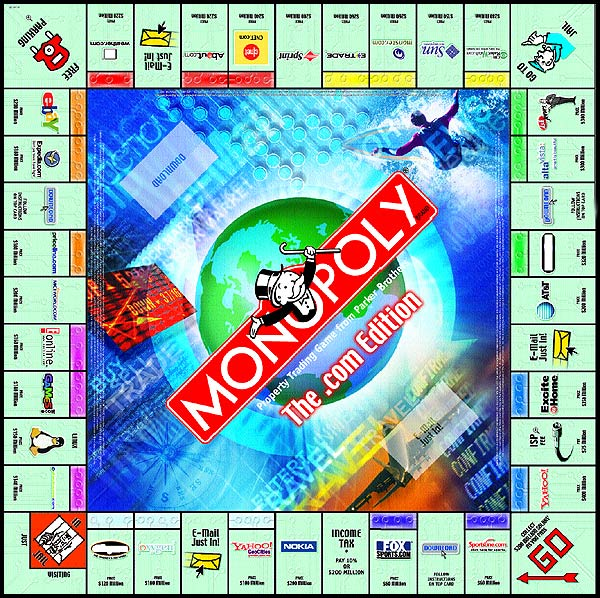Time to read: 5 minutes.
mentoring & advising collection.
People often have difficulty appreciating what an industry is and why it is important to focus their company’s marketing and sales efforts on industries.
Although many people find this topic dry, boring and abstract, they can relate more easily when discussing how the game of Monopoly works. If they played Monopoly when they were kids, they understand this topic better.
The Monopoly Acquisition Strategy
Well, yes, the objective is capitalism at its most extreme: world dominance. I don’t want to get into a discussion about the morality of that; instead, let’s see what life truths we can learn from a study of the game. Personally, much of what I later learned from Machiavelli from reading The Prince, I had already learned from playing two board games as a child: Monopoly and Risk.
If you played Monopoly as a child, you may recall that each player starts with $2000. Each player successively rolls two dice and moves their token around the board. Each time someone lands their token on an unowned property, they have the option of purchasing it. If they choose not to buy it, the property goes up for auction. Players collect $200 each time they circumnavigate the board and pass the spot on the lower right called Go.
That’s great; here we have players going around and around the board, spending money and amassing properties. You remember what happens when someone lands on property that is already owned by someone else, don’t you? They pay rent! Here is where a little strategy pays off; if you own all the properties in a color group (like all three green properties: Pacific Avenue, South Caroline Avenue and Pennsylvania Avenue), then the rent doubles. That sounds great, until you realize that each of those three properties costs $300 or more (a total of $920, actually), and the rent varies from $26 to $28. So even with doubled rents, you’d need other people to land on those properties eighteen times before they paid for themselves! When you consider that you probably land on one of those properties once every four or five times around the board, you realize that this is not exactly life in the fast lane.
But there is something extra that you can do when you own all the properties in a color group: develop them. That’s right, progress at its finest! Put houses on those properties, and raise the rent! In fact, when you have the maximum four houses on Pennsylvania Avenue, you collect $900 each time someone lands on it! Now, your investment here is substantial because each house costs $200, and there is a rule that says you must develop all properties in a color group evenly. What this means is that you must put at least three houses on the other two properties, at $200 each. So, you’ve really spent $2000 in development, but developed properties really pay off much better than undeveloped properties. In fact, the payoff is structured to increase disproportionately as the investment increases. What this means is that your return really balloons as you maximize the number of houses.
OK, OK, you can go maximize your profitability and replace four houses with a hotel, and collect even more rent, but let’s start relating some of this to the real world.
Consider this analogy: Monopoly properties are like your individual customers, and when you have enough similar customers (a complete color group), you have established a market presence. If you have properties here and there, scattered around the board, but no complete color groups, then you can’t develop them by adding houses or hotels. The rent stays low. Your investment just doesn’t give you an adequate return.
What I’m saying is that Monopoly teaches us that if we don’t select our customers with care, then we end up scattering our investment (usually time and manpower) all over the place, with little return. Once we recognize that certain customers are similar enough to be considered in the same or similar industries, then we will court their business because our strategy is to own all the properties in a color group; our investment will really pay back when we focus on industry-specific markets.
A market is a group of customers with similar needs who reference each other when making a purchasing decision.
Adapting Strategy to the Development of the Game
At first, no one has property, and hence no significant income. Conversely, no one has significant expenses. (Of course this is not true for all startups the real life.)
The cheapest properties are the five at the bottom of the screen, in the dark purple and light blue color groups. Not only are they cheap to purchase, they are cheap to develop, and rents are correspondingly modest. At the beginning of the game, these properties are great to develop first, because you can afford to do so. Hey, the dark purple group (Baltic Avenue and Mediterranean) can be purchased and fully developed with two hotels for a total investment of $620. Rents are then $250 and $450, respectively, but at the beginning of the game, you, as a junior tycoon, would enjoy a real leg up with those two income-producing properties.
Contrast the cost of purchasing and developing the Baltic/Mediterranean group ($620) with the Pacific/South Carolina/Pennsylvania group ($2420)! What we rapidly begin to see here is that developing the cheaper properties works best at the beginning of the game, and the more expensive properties tend to be developed near the end of the game (when the players have the cash flow to sustain the development). Developing midrange properties is a mid-game strategy.
One of the worst things your company could do would be to take on an endgame development project when you are just starting out!
Landing that big contract will use up all your resources, unless you’ve got a sugar daddy ready to bail you out. If you’re entering a market that is already fairly well developed, then you need to be able to access a similar level of resources as your competitors.
Moral
The moral: look for development projects in industries that match the level of development of your company. New industries are often good for small, young companies. Mature industries usually mean that large companies own them. Define your company’s role in your industry according to your level of development and resources, compared to the industry as a whole, and the level of development of your customers and competitors.
















